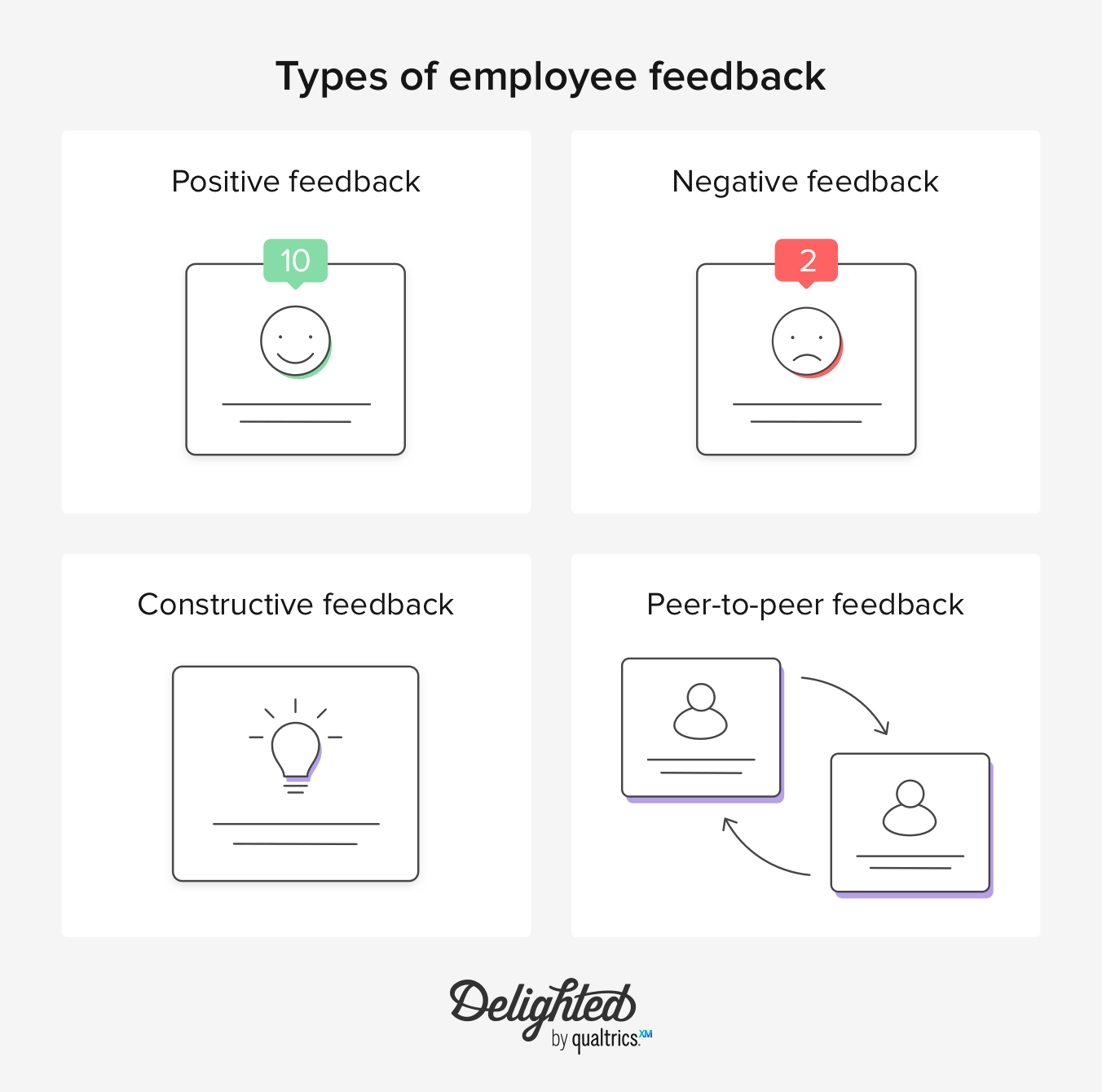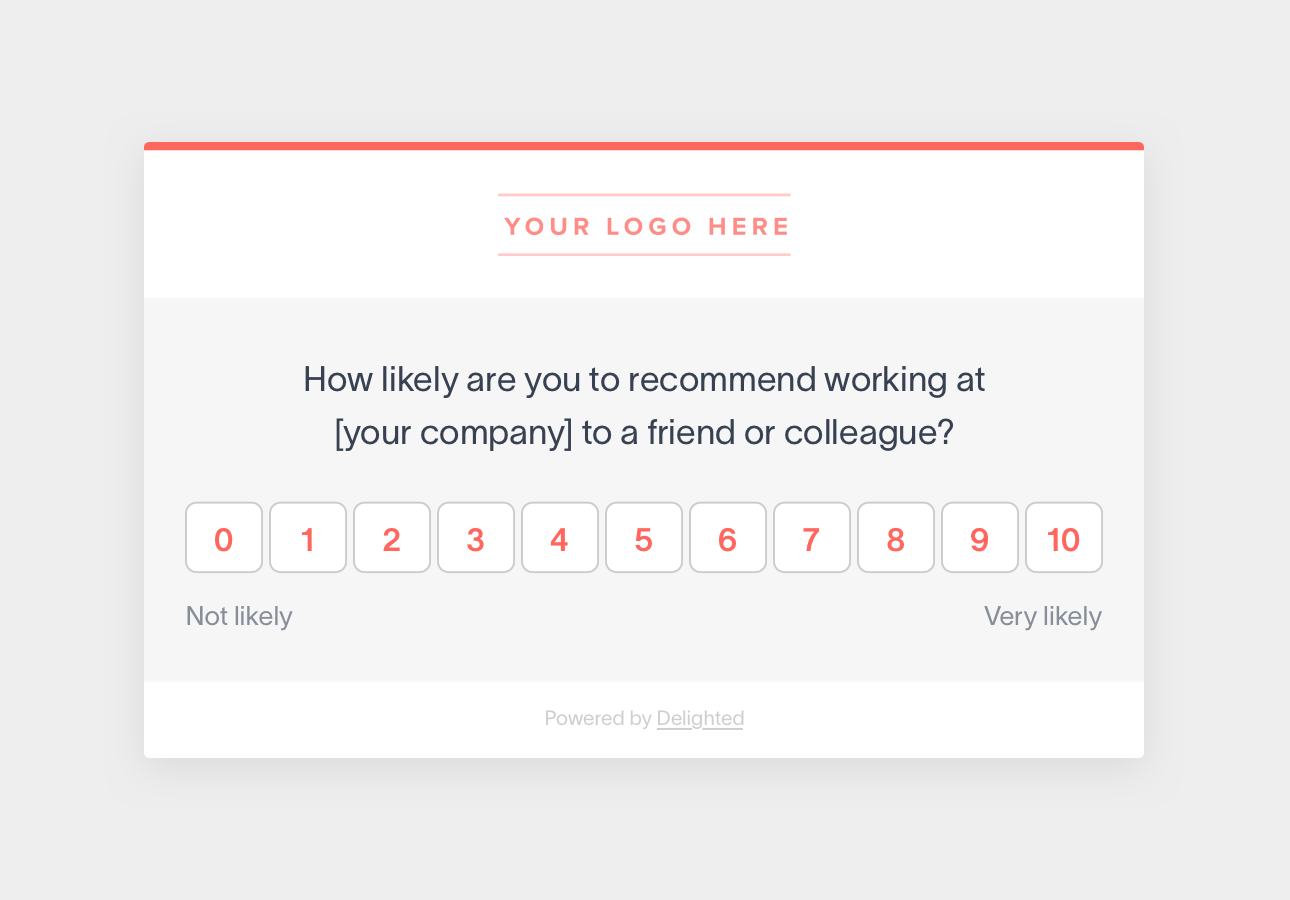Employee feedback is an instrumental part of creating a feedback culture, which enables employees to understand exactly what they need to do to thrive in their role.
When done right, providing continuous employee feedback can dramatically improve employee engagement – guaranteeing improved productivity and employee success.
In this guide, we’ll take a closer look at what employee feedback is, why it’s important, and how to deliver positive, negative, or constructive feedback with examples, so that peers and managers alike will be able to give and receive feedback with confidence.
Jump to:
- What is employee feedback?
- Why is employee feedback important?
- Types of employee feedback with examples
- 10 strategies for giving and receiving effective employee feedback
- Taking action on employee feedback
What is employee feedback?
Employee feedback is information exchanged with employees regarding work performance, skills, or behavior. When facilitated correctly, delivering employee feedback (either by a manager or a peer) can boost individual performance, foster a better sense of belonging at work, and improve business outcomes.
Why is employee feedback important?
Fostering a culture of sharing feedback is a clear benefit to the companies that do – and an obvious detractor for those that do not.
- Employees want feedback. In fact, 75% of employees believe feedback is valuable and critical to their work, and over a third (33.4%) of employees want more manager feedback.
- It increases motivation and productivity. Companies that practice continuous feedback have employees that are 3.6 times more likely to strongly agree that it motivates them to do outstanding work.
- It reduces turnover. Feedback has a positive impact on the bottom line. Companies that give continuous employee feedback can reduce their turnover by almost 15%.
- It boosts employee engagement. The numbers don’t lie: 98% of employees fail to be engaged when managers give little or no feedback. Gallup has estimated that disengaged employees can cost an organization approximately $3,400 for every $10,000 of salary.
However, when feedback is not delivered (or not delivered appropriately), it can be detrimental to an employee’s performance and well-being, to team morale and dynamics, and to overall customer satisfaction and business outcomes.
Let’s take a look at employee feedback examples and clarify how to give feedback to employees in a way that’s healthy and productive for your team and your company.
Types of employee feedback with examples
There are several ways to categorize feedback, from how it’s delivered (formal versus informal), who’s delivering it (manager to employee, or peer-to-peer), to feedback in terms of sentiment.

Positive employee feedback
Positive feedback reinforces the good work employees are doing. It celebrates their wins and accomplishments. Receiving positive feedback helps employees feel valued, and signals to them (and their team members) that their contributions are recognized. It also helps build a culture that fosters sharing positive feedback as a best practice.
Positive feedback examples
Here are some examples of positive feedback to share with your employees:
- “You’ve been doing a great job and really delivered on that project. Everyone loved how you organized the deliverables and kept everyone on the ball with clear communication.”
- “Great job! I appreciate that you went the extra mile on today’s presentation with the data deep dive. Thank you for doing that.”
- “You have exceptional [enter skill here] skills, which have led to [outcome]. It’s a critical asset to our team’s success.”
Note that in each of these examples, the positive feedback isn’t a generic “Good job!” Whenever you give feedback, positive or otherwise, it should reinforce the specific behavior or attribute that led to the praise.
Constructive feedback
As the name suggests, constructive feedback builds upon an event to help an employee learn and grow from it. One of the best things about constructive feedback is that it can take positive or negative feedback (or a bit of both) and spin it into actionable guidance for the future.
Constructive feedback examples
Here are constructive feedback examples that you can use to improve employee performance in a meaningful way:
- “You’ve been working on improving [enter skill here]. How’s that going? What support do you need in getting to the next level?”
- “Your last presentation showed great improvement. Here are a few ideas I had for the next one.”
- “I want to reflect on [your last deliverable]. What do you think went well, and what can be improved for next time?”
Negative feedback
Negative feedback points out when an employee has missed the mark. Although negative feedback should be addressed as soon as possible to avoid any repetition of the mistake and to allow the employee to work on improvements immediately, it’s important to keep in mind that negative feedback isn’t helpful on its own.
There’s value in giving employees feedback when things have gone wrong, but that can’t be the only way an employee receives feedback. When it is, the effects can be detrimental: more than 17% of people have left a job after receiving negative feedback.
Negative feedback examples
Here are some good feedback examples for delivering negative feedback:
- “Today’s meeting didn’t go as planned. Let’s sit down and talk through what happened. What time works best for you?”
- “You missed Friday’s deadline, and that hurt the team’s ability to meet our goals this week. Can we set some time aside to chat about this?”
- “Your performance this quarter hasn’t been typical of what I expect from you. Let’s come up with a plan to course-correct during our next one-on-one.”
It’s important for a negative feedback session to be a discussion that both parties are prepared for. In each of the examples above, there’s an invitation to foster understanding and collaboration at a set time, so that the employee can be mentally prepared for a potentially uncomfortable conversation.
Peer-to-peer feedback
Peer-to-peer feedback is exchanged between employees. To avoid sounding demeaning or too personal, colleague feedback should give examples of when the employee’s actions have led to a positive impact on the team so the employee can feel confident repeating them. Peer feedback is important for building a team culture of trust, partnership, and growth.
Peer feedback examples
Here are a few colleague feedback examples:
- “Thanks for taking initiative and managing this project!”
- “Your organization skills really help the team track updates on the tasks associated with this project.”
- “This launch performed very well thanks to your hard work!”
Although manager-to-employee feedback is crucial for employee development, peer-to-peer feedback is just as important in boosting morale and keeping employees motivated and engaged with one another and their work.
Still not sure how to give feedback to a colleague, positive or otherwise? Not to worry – we take a closer look at some strategies for giving and receiving employee feedback, below.
10 strategies for giving and receiving effective employee feedback
Remember that feedback is a powerful tool when done right. Even if the conversation might be a challenging one, the outcome will be worth the effort.
Here are 10 strategies for giving and receiving employee feedback depending on the feedback channel.
Strategies for giving feedback on employee performance
Once you know how to give employee feedback, you can start providing the feedback necessary to promote an ongoing cycle of feedback throughout your department or company.
1. Start by creating a formal performance review process.
These reviews, often called annual reviews, are one of the most common tools for giving employee feedback. They present an opportunity to evaluate an employee’s work against their goals and objectives set forth at the beginning of the year.
2. Use regular one-on-one meetings with employees to share both formal and informal feedback.
Creating a culture of feedback means making sure that both employees and managers receive feedback on a consistent basis. Feedback doesn’t have to be limited to performance reviews – it’s an ongoing process.
3. Share real-time feedback often, but not so frequently that the recognition loses meaning.
For example, a great time to share real-time feedback is immediately after an important presentation; speak with the employee right after the meeting to praise them for a job well done.
4. Give praise in group settings.
Team meetings, gatherings, and off-sites are great opportunities for sharing positive feedback on a specific department or employee’s contributions, so everyone’s on the same page for what constitues great work. It’s a great motivator to keep the ball rolling on what they have done well.
Have constructive or negative feedback to share? It’s probably better left for your one-on-one conversations.
5. Set up a team Slack (or other communication tool) channel to share praise and recognition.
Create a space on your communication tools to share positive feedback from customers or managers on employee performance. Not only does this improve employee advocacy, it keeps employees updated on their positive contributions so they can keep up the good work.
Delighted’s Slack integration is a great way to combine positive customer feedback and team visibility to celebrate an employee’s win.
Strategies for receiving employee feedback
In addition to delivering feedback, it’s equally important to ask for feedback on how to improve the employee experience.
The remaining 5 strategies go over how you can create a company-wide approach to asking for feedback on your own performance as a manager, and the company at large.
6. Send surveys throughout the employee lifecycle.
Utilize employee surveys at each stage of the employee lifecycle to give employees an opportunity to share critical feedback about your organization.
Some of the key points to ask for feedback are during the interview process, after employee onboarding, during career milestones, and of course, in the event that an employee decides to leave your company.
7. Capture employee satisfaction with eNPS surveys.

Use an employee Net Promoter Score survey, or eNPS survey, to learn how likely an employee is to refer another potential employee to your organization. This is a great signal for how happy they are at your organization, and invites employees to explain why.
Take a look at some example employee satisfaction survey questions to improve employee satisfaction on a large scale.
8. Utilize employee pulse surveys for routine feedback.
Leverage pulse surveys to ask your employees for shorter, more frequent feedback. This type of survey is helpful for tracking the same item (such as employee sentiment or engagement) over time. Learn more about how to create an effective employee survey in our guide.
9. Prioritize two-way feedback during one-on-one meetings with direct reports.
Schedule one-on-one meetings with your direct reports to ask for feedback on specific topics on your performance as a manager, so you can understand how you can help your team member perform better.
Ask open-ended questions to encourage the conversation, and consider giving your direct report a heads up that you’d like some feedback so the feedback session can be as productive as possible.
10. Consider an enterprise solution for an employee experience program.
Once your organization has implemented some of the foundational strategies above, you may find it’s necessary to expand your employee experience management program, especially if your company has grown. Qualtrics’ Employee Experience suite of EX solutions can help systematize how you ask for employee feedback, including 360 performance feedback.
Taking action on employee feedback
While giving and receiving feedback is important for employees and managers alike, perhaps the most critical part of the equation is taking action on feedback.
Why? According to Qualtrics, asking for employee feedback without taking action on it actually results in worse engagement than if you don’t have an employee experience management program at all.
You want your employees to know that you’ve heard them and will take their feedback seriously. Taking action on feedback after your employees have volunteered their time to provide it builds trust and shows them that you value their insights.
As you’re building out your employee feedback program, be sure to also think through the resources (e.g., talent, technology, and so on) you’ll need – and the communication strategy you’ll utilize – to take action, as well.
Ready to put your knowledge of employee feedback to use? Start gathering feedback with Delighted’s experience management software and send free eNPS surveys in minutes.







